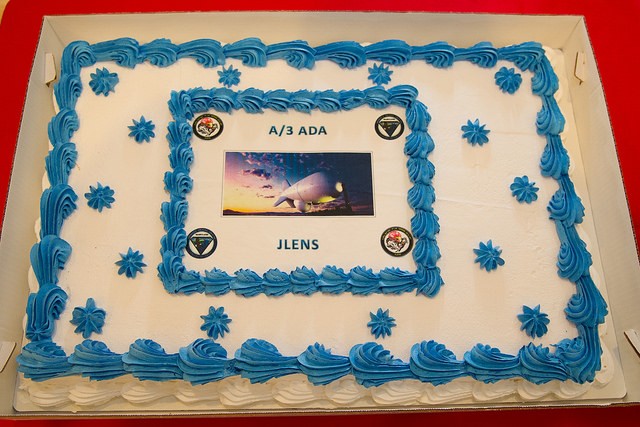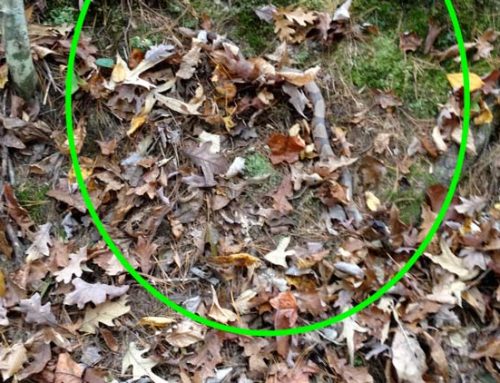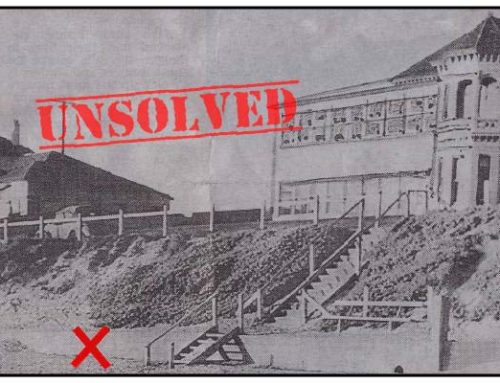NOTE: video for this post is at the end of the article…
Joint
Land
Attack
Cruise
Missile
Defense
Elevated
Netted
Sensor
System
JLENS — it’s that huge blimp, about the size of 3 Goodyear blimps, that hit the national news yesterday. It has already gotten the attention of privacy advocates who question its true purpose. Overseas that purpose, disclosed or not, is already being exercised. Now, however, the Army thinks America is ready for it.
D.C. and Baltimore area residents won’t be able to miss seeing JLENS. A pair of them may have already been tethered and possibly allowed into the sky, although recent reports indicate it won’t happen until perhaps Monday. Wait a couple of more days, and the Army could have wished America “Merry Christmas“… apparently an August celebration of sorts already happened for military personnel – this photograph of a cake was found among a whole set of other images on Flickr.
But know this… They won’t be roaming the skies because they are tethered, the field of view is far-reaching, across an area about the size of Texas, should they be raised to 10,000 feet.

Images from a Yahoo Image searh — Description: The Joint Land Attack Cruise Missile Defense Elevated Netted Senor System (JLENS) is a tactical, theater based, advanced sensor system. JLENS is currently managed as part of the Cruise Missile Defense Systems Project Office at Redstone Arsenal, AL.
Made by Raytheon at a total projected cost of some $5,760,000,000 had all 32 that were called for been delivered, a reduction in the project pegs the remaining two at $1.4 billion each. The Intercept explains:
At one point, there were supposed to be nearly three dozen blimps. But after a series of operational failures and massive cost overruns, the program was dramatically scaled back to the two existing prototypes that the Army plans to keep flying continuously above the Aberdeen Proving Ground for three years, except for maintenance and foul weather.
As for suspected surveillance purposes, EPIC and the ACLU have expressed concerns. The Intercept continues…
“There’s something inherently suspect for the public to look up in the sky and see this surveillance device hanging there,” says Ginger McCall, associate director of the Electronic Privacy Information Center (EPIC), an advocacy group. “It’s the definition of persistent surveillance.”
Army officials claim they have no interest in monitoring anything other than missiles, or maybe boats. But JLENS can detect plenty more than that.
“A lot of people may hear radar and they picture a fuzzy green screen with little blips. But today’s radar is significantly more sophisticated than that and is in some ways akin to a camera,” warns Jay Stanley, a privacy expert for the American Civil Liberties Union.”
Defense Tech counters and sets a different date in their article:
The 80-yard long, radar-fitted surveillance balloons, floated to an altitude of up to 10,000 feet, are intended to pinpoint beyond-the-horizon targets such as incoming enemy missiles, aircraft or drones.
A second balloon, technically aerostats because they’re tethered and do not float or maneuver independently in the sky, is expected to go up by the end of January.One of the two is engineered with VHF radar technology capable of scanning outward to a distance of about 500 kilometers, a Raytheon official and director of the Army’s Joint Land Attack Cruise Missile Defense Elevated Netted Sensor System, JLENS,
And concludes…
Privacy advocates will be happy to know that – according to NORAD – the surveillance balloons are not equipped with spy gear. “The JLENS aerostats cannot see people and do not have cameras onboard”
News to Share hasn’t even scratched the surface of this story, so please check out the sources below PLUS THE VIDEO so you can be properly informed!
VIDEO: Giant Radar Blimp Time-Lapse • Inflating The JLENS
Time-lapse of the inflation of a JLENS aerostat (blimp) at Aberdeen Proving Ground, MD on December 14, 2014. JLENS is short for Joint Land Attack Cruise Missile Defense Elevated Netted Sensor System. JLENS is a system of tethered aerostats that float 10,000 feet in the air. The helium filled aerostats, which are nearly as long as a football field, carry powerful radars that can scan 360 degrees with a range of 340 miles. The system can be used to detect missiles and other aircraft. JLENS will integrate with NORAD to provide early warning protection. More info about JLENS on DefenseTech
News to Share Brief source:
— First Look / The Intercept
— Defense Tech
— for even more information, Wikipedia has a page regarding JLENS too.
Composite of images via Yahoo Image Search results for “JLENS”
Image license CC by 2.0 via Flickr – JLENS_028 cake photo credit Aberdeen Proving Ground




